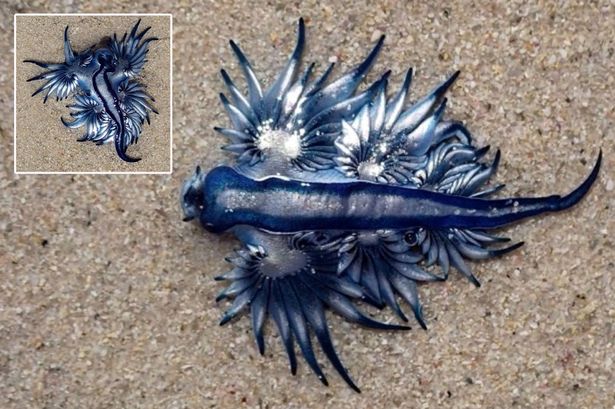A sea creature described as “the most beautiful killer in the ocean” because of its dazzling blue colour and potentially-fatal sting has washed up on an African beach.
The Glaucus atlanticus, commonly known as the blue dragons, were found on Fish Hoek Beach near Cape Town in South Africa by a local woman who was out for a walk.
The sea slug feeds on the deadly Portuguese man o’ war and other venomous marine animals.
It then absorbs the stinging cells from its food and stores them in concentrated doses, which gives it a far more potent sting than its prey.
Typical symptoms of the blue dragon’s sting include nausea, pain, vomiting and acute allergic contact dermatitis.
Maria Wagener, who found the creatures, often helps beached starfish back into the water but had a lucky escape this time when instinct told her to keep her distance.
“I’ve never seen them before and I’ve lived near this beach for most of my life,” she said.
“They’re a bit like a sea scorpion. They are small, about an inch in length. They’re blue on the top and white underneath.
“It wasn’t difficult to spot them on the white sand.”
She continued: “I pick up starfish all the time and put them back into the sea but I had a feeling that these would have a sting.
“I probably would have put them back in the sea if I’d had something to lift them.
“So no, I didn’t touch them!”
Mrs Wagener estimates that she found 20 on the beach but says there “could have been more”.
And if there was any doubt as to whether the creatures had been ingesting venom from their prey, the grandmother found the evidence right down the beach.
“There were also a variety of other species of sea life,” she said.
“There were little blue crabs, Portuguese men o’ war, and blue shells called Janthina Janthina.”
Luckily, the blue dragons probably didn’t need Maria’s help.
She said: “They were still very much alive when I saw them. The tide would have taken them back to the sea.”
Mrs Wagener shares photos of her beach discoveries on her Facebook page, Fish Hoek Beach .



